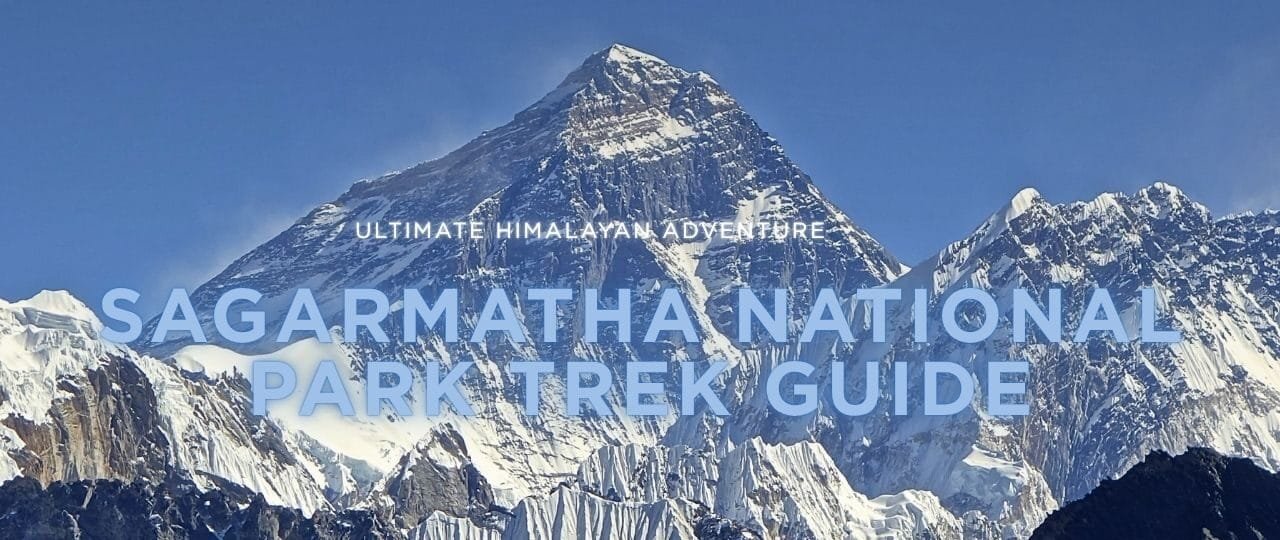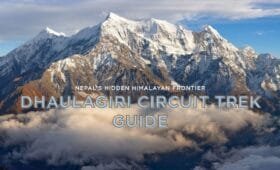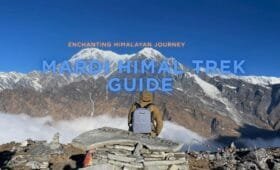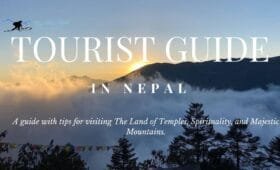The Sagarmatha National Park Trek is one of Nepal’s most iconic trekking experiences, blending awe-inspiring natural beauty with rich Sherpa culture. This comprehensive trek takes you through rugged terrain, lush valleys, and up to breathtaking high-altitude landscapes within the Sagarmatha National Park—home to Mount Everest. Whether you’re drawn to the thrill of the Annapurna Conservation Area Trek or the challenge of the Langtang National Park Trek, the Sagarmatha route offers an unforgettable journey with remarkable vistas, authentic cultural experiences, and the opportunity to support local communities through Volunteers Initiative Nepal (ViN).
This detailed guide explores every aspect of the Sagarmatha National Park Trek. We cover the itinerary, cost, difficulty, permits, maps, best times to trek, and essential tips to help you plan your adventure. With expert insights, testimonials, and actionable advice, this guide is designed to prepare you for an extraordinary Himalayan journey that satisfies your wanderlust and positively impacts local communities.
1. Introduction: Discover the Magic of Sagarmatha National Park Trek
The Sagarmatha National Park Trek is more than just a trek—it is a journey into the heart of the Himalayas, where nature, culture, and spirituality converge. As you traverse this majestic trail, you will experience the raw beauty of Nepal’s high-altitude landscapes and the enduring spirit of the Sherpa people. Whether you’re an experienced trekker or a novice adventurer, the Sagarmatha National Park Trek promises breathtaking panoramas, challenging ascents, and a profound connection with nature.
The trek starts at Lukla, a bustling airstrip that marks your gateway to the Everest region. It gradually ascends through verdant valleys and ancient villages. Along the way, you will witness the evolution of the terrain—from the subtropical forests near the base to the stark, rugged beauty near Everest Base Camp. This guide will provide a detailed Sagarmatha National Park Trek Itinerary, cost estimates, and practical tips to help you navigate this epic adventure.
History
2. Historical and Cultural Significance
2.1 The Legacy of Sagarmatha National Park
Sagarmatha National Park, designated as a UNESCO World Heritage Site, is a natural wonder and a cultural treasure trove. The park is home to Mount Everest (Sagarmatha in Nepali), the highest peak in the world, and its surrounding landscapes offer a window into the rugged beauty and harsh realities of life at high altitudes. Early explorers and climbers like Sir Edmund Hillary and Tenzing Norgay were drawn to this region, and their pioneering spirit still echoes along its trails.
2.2 Sherpa Culture and Local Traditions
The trek offers an immersive experience of the vibrant Sherpa culture. Traditional villages, Buddhist monasteries (gompas), and colorful prayer flags constantly remind visitors of the region’s spiritual heritage. Local festivals, ancient rituals, and the warm hospitality of the Sherpa people add a profound cultural dimension to the Sagarmatha National Park Trek. Many trekkers recount how engaging with the locals provided insights into their resilient way of life and deep-rooted traditions.
“The Sagarmatha trek changed my perspective on life. The mountains are not just beautiful but steeped in history and culture. I was touched by the Sherpa people’s kindness and the monasteries’ spiritual aura along the trail,” shares Tsering, a trekker from India.
Itinerary
3. Detailed Itinerary: Your Sagarmatha National Park Trek Itinerary
A well-planned Sagarmatha National Park Trek Itinerary is crucial for balancing adventure with proper acclimatization. Here’s a sample 14-day itinerary designed to give you a comprehensive experience of the park:
Day 1: Arrival in Kathmandu
- Activities: Explore Thamel, arrange permits, and attend a briefing.
- Overnight: Hotel in Kathmandu.
Day 2: Kathmandu to Lukla
- Transport: Fly from Kathmandu to Lukla (~2,840m).
- Activities: Brief orientation at Lukla.
- Overnight: Teahouse in Lukla.
Day 3: Lukla to Phakding
- Trekking Duration: 3-4 hours.
- Route: Descend gently from Lukla along the Dudh Koshi River.
- Highlights: Scenic views, local villages.
- Overnight: Teahouse in Phakding (~2,610m).
Day 4: Phakding to Namche Bazaar
- Trekking Duration: 5-6 hours.
- Route: Cross suspension bridges over the Dudh Koshi; ascend gradually to Namche Bazaar (~3,440m).
- Highlights: First encounter with Sherpa culture.
- Overnight: Teahouse in Namche Bazaar.
Day 5: Acclimatization in Namche Bazaar
- Activities: Hike to Everest View Hotel, explore local markets, and visit the Sand Herpa Museum.
- Purpose: Acclimatization is key.
- Overnight: Teahouse in Namche.
Day 6: Namche Bazaar to Tengboche
- Trekking Duration: 5-6 hours.
- Route: A gradual ascent with panoramic views of Everest, Ama Dablam, and Lhotse.
- Highlights: Tengboche Monastery.
- Overnight: Teahouse in Tengboche (~3,867m).
Day 7: Tengboche to Dingboche
- Trekking Duration: 5-6 hours.
- Route: Continue the ascent through pine forests and terraced fields.
- Highlights: Stunning vistas, cultural immersion.
- Overnight: Teahouse in Dingboche (~4,410m).
Day 8: Acclimatization in Dingboche
- Activities: Short day hikes to Nangkartshang or Chhukung Valley.
- Purpose: Prepare for the higher altitudes.
- Overnight: Teahouse in Dingboche.
Day 9: Dingboche to Lobuche
- Trekking Duration: 5 hours.
- Route: Descend slightly, then climb and pass memorial sites.
- Overnight: Teahouse in Lobuche (~4,910m).
Day 10: Lobuche to Gorak Shep & Everest Base Camp
- Trekking Duration: 7-8 hours.
- Route: Trek from Lobuche to Gorak Shep (~5,164m), then briefly visit Everest Base Camp (~5,364m).
- Highlights: The iconic view of the Khumbu Icefall.
- Overnight: Return to Gorak Shep.
Day 11: Gorak Shep to Kala Patthar & Return
- Trekking Duration: 6-7 hours.
- Route: Early morning hike to Kala Patthar (~5,545m) for a panoramic sunrise, then descend back to Gorak Shep.
- Overnight: Teahouse in Gorak Shep.
Day 12: Gorak Shep to Namche Bazaar
- Trekking Duration: 6-7 hours.
- Route: Descend the same path, enjoying changing vistas.
- Overnight: Teahouse in Namche Bazaar.
Day 13: Namche Bazaar to Phakding & Lukla
- Trekking Duration: 5-6 hours to Phakding, then transfer to Lukla.
- Overnight: Teahouse in Lukla.
Day 14: Lukla to Kathmandu
- Transport: Fly from Lukla to Kathmandu.
- Activities: Debrief, final souvenirs, and relaxation.
- Overnight: Hotel in Kathmandu.
This Jiri to Everest Base Camp Trek Itinerary variation emphasizes the integration of acclimatization, cultural exploration, and scenic trekking, providing a balanced itinerary for a successful expedition.
4. The Trek Route and Distance
The Jiri to Everest Base Camp Trek Distance is considerable, with the entire trek covering approximately 160–180 km round-trip. The route is longer than the typical Lukla approach, offering a more gradual ascent and diverse terrain. It takes you through remote, less-traveled villages, scenic river valleys, and rugged mountain paths.
- Jiri to Naubise: The initial part of the trek covers gentle slopes, introducing you to the transition from lowland to high-altitude terrain.
- Naubise to Phaplu: This trek section becomes more challenging, with gradual ascents and increasing altitude.
- Phaplu to Tengboche is the most scenic stretch, with dramatic views of Himalayan giants and culturally rich villages.
- Tengboche to EBC via Lobuche and Gorak Shep: The final ascent brings you into the world’s highest mountains.
Utilizing a detailed Jiri to Everest Base Camp Trek Map is essential. These maps, available from local trekking agencies, mark every suspension bridge, teahouse, and significant checkpoint, ensuring you stay on track even as the terrain becomes challenging.
5. Assessing Trek Difficulty
The Jiri to Everest Base Camp Trek Difficulty is generally rated as advanced due to the long distances, variable terrain, and high altitudes. Key challenges include:
- Altitude Gain: The trek ascends roughly 1,200m in Jiri to over 5,300m at Everest Base Camp. The gradual increase helps acclimatize, but trekkers must be prepared for significant altitude changes.
- Length & Duration: The 160–180 km trek, which takes 14–15 days, demands sustained physical endurance.
- Rugged Terrain: Steep ascents, rocky paths, and sometimes slippery trails in rainy conditions add to the challenge.
- Weather Variability: The weather can shift suddenly, especially near the higher elevations, affecting visibility and trail conditions.
For trekkers with previous high-altitude experience, the Jiri to Everest Base Camp Trek Difficulty is manageable with proper preparation. However, for novices, engaging a Jiri to Everest Base Camp Trek Guide is advisable for both safety and cultural insights.
Budget
6. Budget Considerations and Trek Cost
Understanding the Jiri to Everest Base Camp Trek Cost is critical for planning your adventure. Expenses vary by individual choices, such as transportation mode, accommodation type, and whether you hire a guide or porter.
Cost Breakdown:
- Transport:
- Kathmandu to Jiri: Public bus/jeep – approximately USD 10–20 per seat; private jeep (shared) – around USD 100–150.
- Lukla Return Flight: Approximately USD 180–200 each way (if choosing to fly back from Lukla instead of trekking down).
- Accommodation & Meals:
- Teahouse Lodging: Ranges from USD 3–6 per night in lower altitudes, increasing to USD 5–8 at higher elevations.
- Daily Meals: Approximately USD 20–30 per day, varying with altitude and food availability.
- Permits:
- Sagarmatha National Park Permit: Approximately USD 30.
- TIMS Card: Approximately USD 10–20.
- Local Municipality Fees: Approximately USD 20.
- Guide & Porter Fees:
- Guide: About USD 25–30 per day.
- Porter: Roughly USD 15–20 per day.
- Miscellaneous:
- Hot showers, Wi-Fi, charging fees, and gear rentals (if needed).
For a 14–15 day trek, a budget trekker might manage with around USD 700–1,200 for an introductory, teahouse-based trek. A complete package, including guided services, could range between USD 1,200 and 2,000.
7. Permits and Documentation Requirements
For the Jiri to Everest Base Camp Trek, the following permits and documents are essential:
- Sagarmatha National Park Permit: Required for trekking in the Everest region, costing around USD 30.
- TIMS Card: Trekkers must have this card, typically costing USD 10–20.
- Local Municipality Fees: A small fee (around USD 20) might be required depending on your route.
- Passport and Visa: Always carry your passport, visa, and passport-sized photos for registration at checkpoints.
These permits ensure that trekking activities support local conservation efforts and cultural heritage preservation. Purchasing them in Kathmandu or through a registered trekking agency is advisable.
Best Time
8. Best Time to Trek: Weather and Seasonal Considerations
The Jiri to Everest Base Camp Trek Best Time is crucial for a safe and enjoyable experience. The ideal seasons include:
Autumn (September to November)
- Weather: Clear skies, stable weather, and crisp mountain views.
- Temperature: Daytime temperatures are pleasant; nights can be cold, especially at higher altitudes.
- Crowds: Peak trekking season, so teahouses and flights may be busy.
Spring (March to May)
- Weather: Mild temperatures, blooming rhododendrons, and vibrant scenery.
- Temperature: Comfortable daytime warmth with occasional showers.
- Crowds: Moderate; slightly less crowded than autumn.
Winter (December to February)
- Weather: There are fewer trekkers and clear but cold days, especially in the higher regions.
- Temperature: Nights can be freezing; proper gear is essential.
- Crowds: Minimal, offering solitude but harsher conditions.
Monsoon (June to August)
- Weather: Heavy rainfall, slippery trails, and potential flight delays.
- Temperature: Cooler, but the risk of landslides and leeches increases.
- Recommendation: Generally not recommended for trekking.
Thus, the best time to do the Jiri to Everest Base Camp Trek is autumn or spring, when weather conditions are optimal, and mountain views are most apparent.
9. Accommodation Options Along the Trek
Jiri to Everest Base Camp Trek Accommodation is typically teahouse-based:
- Jiri: Basic guesthouses or lodges, often family-run.
- Phakding & Naubise: Simple teahouses with basic amenities.
- Namche Bazaar: Offers a range of accommodations—from basic dormitories to more comfortable private rooms with additional services such as Wi-Fi and hot showers.
- Tengboche, Dingboche, Lobuche, and Gorak Shep: More basic lodging; expect shared facilities, communal dining, and minimal heating.
- Everest Base Camp Area: Lodging is limited, so plan accordingly if you intend to stay overnight at or near Base Camp.
Prices typically increase with altitude due to limited availability and higher transport costs. Budget around USD 3–6 per night for basic teahouses, with meals averaging USD 20–30 daily.
Tips
10. Practical Trekking Tips and Packing List
10.1 Essential Gear for the Trek
A comprehensive Jiri to Everest Base Camp Trek Packing List should include the following:
- Clothing: Thermal base layers, a fleece or down jacket, a waterproof shell, trekking pants, moisture-wicking t-shirts, and a warm hat.
- Footwear: Sturdy, well-broken-in trekking boots, multiple pairs of socks, and gaiters for muddy or snowy conditions.
- Accessories: Trekking poles, a sun hat, sunglasses, gloves, and a buff or scarf.
- Backpack: A comfortable daypack (25–35L) to carry essentials.
- Hydration: Reusable water bottles, a hydration system, and water purification tablets.
- Gear: A headlamp with extra batteries, a camera with spare memory cards, a power bank, a personal first-aid kit, and a multi-tool.
- Documents: Passport, copies of permits (Sagarmatha NP Permit, TIMS Card), travel insurance, and extra passport photos.
10.2 Additional Trekking Tips
Keep it Light: Pack only essentials to avoid unnecessary strain on steep climbs.
Acclimatize: Allow extra days in Namche Bazaar or Dingboche for proper acclimatization.
Hydrate: Drink plenty of water—aim for at least 3 liters a day.
Pace Yourself: Maintain a steady pace; use trekking poles for support on steep ascents and descents.
Weather Preparedness: Carry a waterproof jacket and extra warm layers for unpredictable weather conditions.
Respect Local Customs: Always greet locals with “Namaste,” ask for permission before photographing, and follow the traditions of monasteries.
FAQs
11. The Seven Most Frequently Asked Questions
1. What is the total distance of the Jiri to Everest Base Camp Trek?
The trek covers approximately 160–180 km round-trip, depending on route variations and detours.
2. How difficult is the Jiri to Everest Base Camp Trek?
It is generally considered advanced due to its long distances, high altitudes, and rugged terrain, which require proper acclimatization and fitness.
3. How long does the trek typically last?
A standard itinerary spans 14–15 days, including transport, trekking, and acclimatization days.
4. What is the estimated cost for the trek?
For an introductory, teahouse-based trek, costs typically range from USD 700–1,200. Package deals with guides and porters may range from USD 1,200–2,000.
5. Which permits are required?
You need a Sagarmatha National Park Permit (~USD 30), a TIMS Card (~USD 10–20), and possibly additional local municipality fees (~USD 20).
6. What is the best time to undertake the trek?
The best time is autumn (Sept–Nov) or spring (March), with stable weather and clear mountain views.
7. Do I need a trekking guide for this route?
While not mandatory, a guide (approx. USD 25–30 per day) is highly recommended for safety, local insights, and logistical support.
12. Conclusion
The Jiri to Everest Base Camp Trek is more than an adventure—it is a transformative journey through the heart of the Himalayas. This route, steeped in history and cultural richness, offers trekkers an authentic experience that balances rugged natural beauty with deep local heritage. The trek’s extended distance and challenging ascents require physical preparedness. Still, the reward is a panoramic glimpse of Everest, a profound immersion in Sherpa culture, and an intimate encounter with one of the world’s most legendary mountain regions.
Make a Double Impact with Volunteers Initiative Nepal (ViN)
Volunteers Initiative Nepal (ViN) organizes charity trekking and travel tours, where all proceeds go toward community empowerment. When you join the Jiri to Everest Base Camp Trek with ViN, you embark on a life-changing adventure and contribute to sustainable projects that uplift local communities.
- Volunteer: Engage directly in community projects—education, environmental initiatives, or health services.
- Intern: Merge your academic or professional pursuits with hands-on experience in Nepal’s highlands.
- Donate: Even small contributions help fund essential local projects, from school renovations to healthcare improvements.
- Share: Spread the word to friends, family, and social networks, inspiring others to join this philanthropic trekking movement.
Namaste—and may your Himalayan journey elevate your spirit and leave a lasting impact on the communities that welcome you.
Guidance
13. Extended Practical Guidance & Final Thoughts
13.1 Seasonal Breakdown & Weather
- Autumn (Sept–Nov): Ideal trekking conditions—crisp, clear, and relatively dry. Temperatures are comfortable during the day, with chilly nights.
- Spring (Mar–May): The region bursts into bloom with rhododendron flowers. Daytime temperatures are pleasant, with occasional showers.
- Winter (Dec–Feb): There are fewer trekkers, but expect cold temperatures, especially at high altitudes. Trek safely with proper gear.
- Monsoon (Jun–Aug): Heavy rainfall and muddy trails are typical. Flight delays and slippery paths can hamper your trek.
13.2 Acclimatization & Fitness Preparation
Prepare well in advance. Incorporate cardio workouts, long hikes, and stair climbing. Allow extra days at key stops like Namche Bazaar and Dingboche to acclimatize correctly and minimize the risk of altitude sickness.
13.3 Cultural Engagement & Local Insights
Embrace the local culture. Engage with Sherpa communities, explore ancient monasteries, and learn about local customs. A few days in Namche can be spent visiting local markets, experiencing traditional dances, and sampling authentic Sherpa cuisine.
13.4 Packing Essentials
Make sure your Jiri to Everest Base Camp Trek Packing List is complete:
- Thermal and waterproof clothing layers.
- Sturdy trekking boots and comfortable socks.
- Trekking poles, hats, gloves, and sunglasses.
- Daypack with water, snacks, and basic first-aid supplies.
- Essential documents: Passport, permits, TIMS card, and travel insurance.
13.5 Overcoming Challenges
Plan for potential challenges such as:
- Altitude Effects: Monitor for symptoms like headache, nausea, or dizziness.
- Weather Variability: Be prepared for sudden changes; always carry a waterproof layer.
Crowds: Although the Jiri route is less crowded than Lukla, peak season can still mean busy teahouses. Booking in advance can help.




